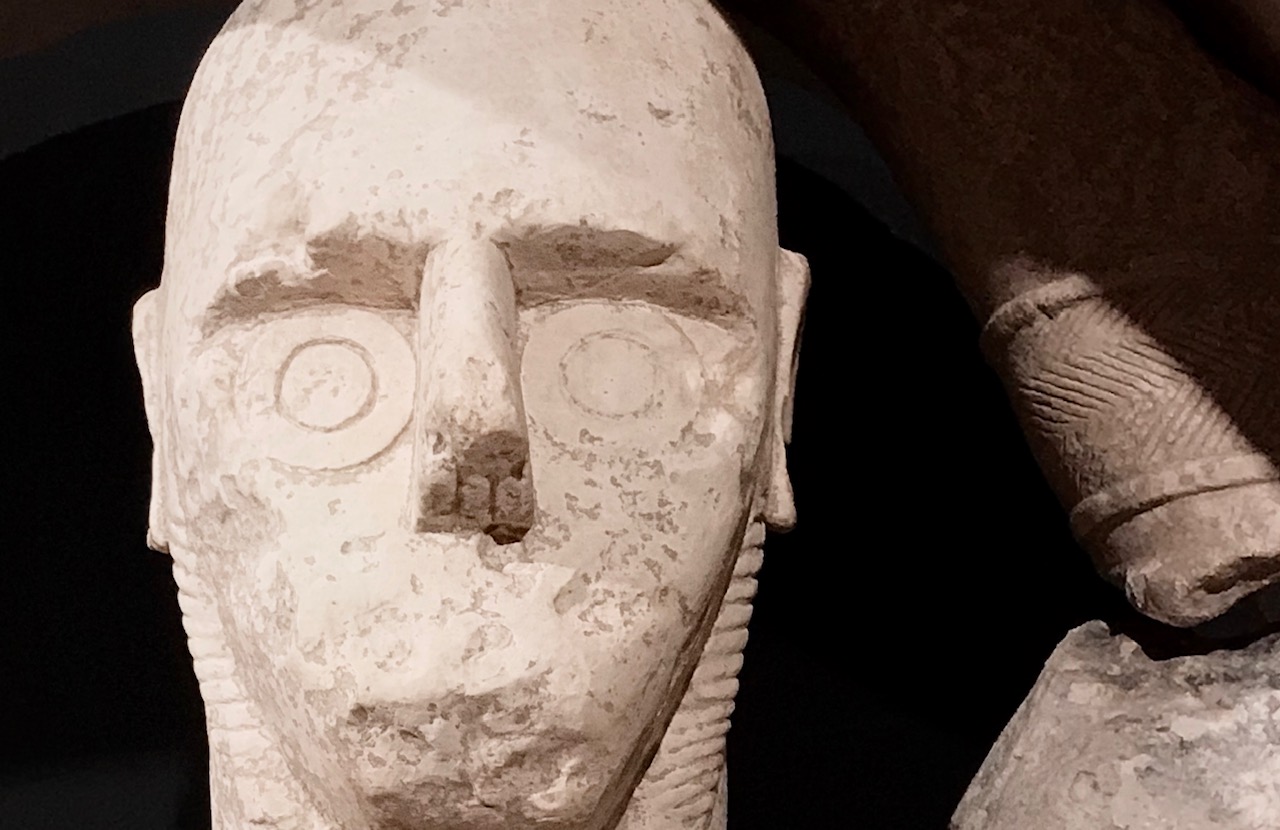Giants Of Mont'e Prama 0 Comments

Leaving from Gabbiano Azzurro Hotel & Suites and traveling 2 hours and 20 minutes South, via Nuoro town, or West, via Berchidda, on the Sinis peninsula, central western Sardinia, there is the very interesting Monte Prama Archaeological Site.
Human settlement on the Sinis peninsula begins in the Middle Neolithic (5th millennium BC). It continues in the following periods of the Middle Bronze Age (1700-1365 BC) and of the recent Bronze Age (1365-1200 BC) when the settlement was amplified with an important system of Nuragic tholos. In the Cabras territory 75 constructions, of which 47 single towers and 28 complexes, arrived to our days unfortunately in a poor state of conservation. The Phoenicians began to arrive there from the end of the eighth century BC, leaving their oldest vestiges in the city of Tharros. The evidence of their permanent settlement is given by the open-air sanctuary dedicated to the goddess Astarte, the tofet, where hundreds of urns containing children, babies and animal ashes were found. With the Roman conquest of 238 BC, also the Sinis territory underwent their occupation which lasted for several centuries. What remains of the Roman Tharros is the tempietto K, (indicated with the letter K by its discoverer), and the orthogonal scheme structures of Murru Mannu. The Romans gave Tharros three Spas, the castellum aquae, some temples, a streets system paved with basalt slabs and a sewer system. The discovery of 78 lead seals from the Byzantine era is important: 72 Byzantine specimens (6th-8th century AD), two from the Judicate of Arborea (11th century) and four Islamic ones. Tharros became depopulated when the Judicate’s capital was transferred to Oristano (learn more about: Tharros The Phoenician Town).
In the Sinis Peninsula, in the Mont’e Prama hill, during the ploughing of the fields, very important finds were accidentally brought to light. Between 1975 and 1979 the first 5178 fragments of statues were found (after successive excavations they would become more than 10,000 fragments). Pieces of heads, busts, arms, legs and shields which, in the Li Punti (Sassari) Restoration and Conservation Centre, have been meticulously reconstructed, turning them into 28 huge stone statues figuring two meters high humans. A proud warrior aristocracy of mysterious origin. However, although the findings were discovered in a necropolis, it is almost certain that they were not part of it. Maybe the statues belonged to a temple, not far from the necropolis. An iconoclastic fury struck the statues brutally, decapitating the bodies and erasing their eyes. It is still a mystery on who wanted to destroy the statues and intentionally accumulated their pieces in the necropolis. The stone warriors were dated to be of the seventh century BC., but there are scholars who suggest they might belong to the eleventh century BC., in which case Sardinian statuary art would precede the one of ancient Greece. The first sculptures of the western Mediterranean could therefore be attributed to the Nuragic.
The most important Nuragic necropolis had been discovered, a hero’s sepulchre, covered by an aura of legend. The statues represent young men: 16 boxers, 6 archers, 6 warriors. The boxers, shirtless and wearing a pointed skirt, a glove in the right arm and a light shield held over their head. Archers and warriors wear a short tunic and horned helmet, and while archers hold the bow with their left arm protected by a sheath, the warriors protect themselves with a round shield. The 28 mighty sculptures are the only stone statues in the Mediterranean, dating back to three thousand years ago, given us back by the Nuragic world. A glorious past represented by the Giants of Mont’e Prama, a great symbol of a formidable civilization handed down to posterity. And the restoration of the giants gives mysteries every day, one of these is the discovery that the black and perhaps even red colour was decorating the statues, an animal pigment found over the stone "skin" of the giants.
The origin of the name "Mont'e Prama", which would lead to an easy Palm Mount (Monte delle Palme), could have a much deeper and more beautiful meaning. Linked to the courage of the giant heroes who won the fear (in sardinian sa sprama) of death, were consecrated in a place, which perhaps had palm trees, but whose meaning was in honour of their mystical and sacred value, because they were not just warriors, they were Sacred Warriors.
However, it is a story in continuous development: in fact the geophysicist Gaetano Ranieri, thanks to his georadar, says that there are "Sixteen hectares still to be excavated", buried not far from the Cabras pond where the pink flamingo nest (learn more about: Sa Genti Arrubia: Pink Flamingos Of Sardinia). We hope that the starting of the new excavations is near, so that they can give us God knows how many and what wonderful archaeological treasures, which can gradually dispel the mystery of the Giants of Mont'e Prama, which sometimes even tinges with extra-terrestrial hypotheses. Looking at those eyes with virtually alien concentric circles, one would like to be able to guess the mystery guarded by statues so majestically enigmatic. But concentric circles and spirals are often found engraved in the Nuragic monuments ... who knows.
"Amsicora looks up at the Statue of the Human-God who previously he could not look at. It's a split second, but full of meaning: the farewell from the Heroes place is like a handover between the rock-made representatives from a glorious past to those who are called to revive its splendour." (from the book: Sandahlia the Two Faces of the Soul by Stefano Piroddi on the Giants of Mon'te Prama).
--
Written by Daniela Toti
Photo credits Laura Mor
Share your opinion with us!